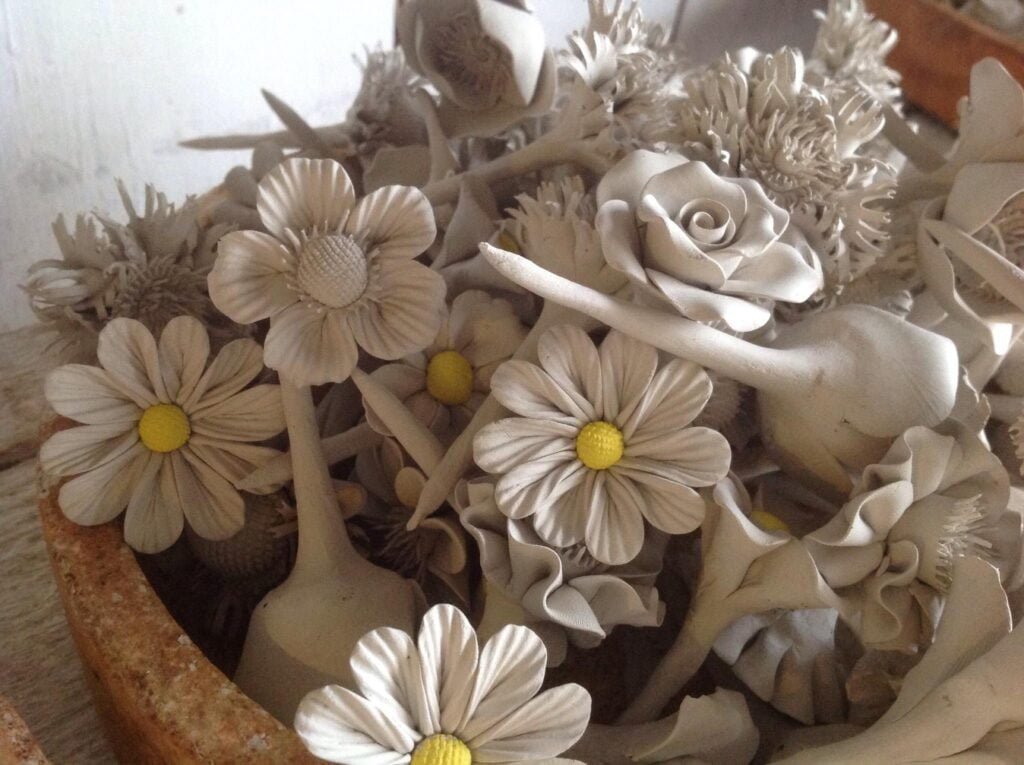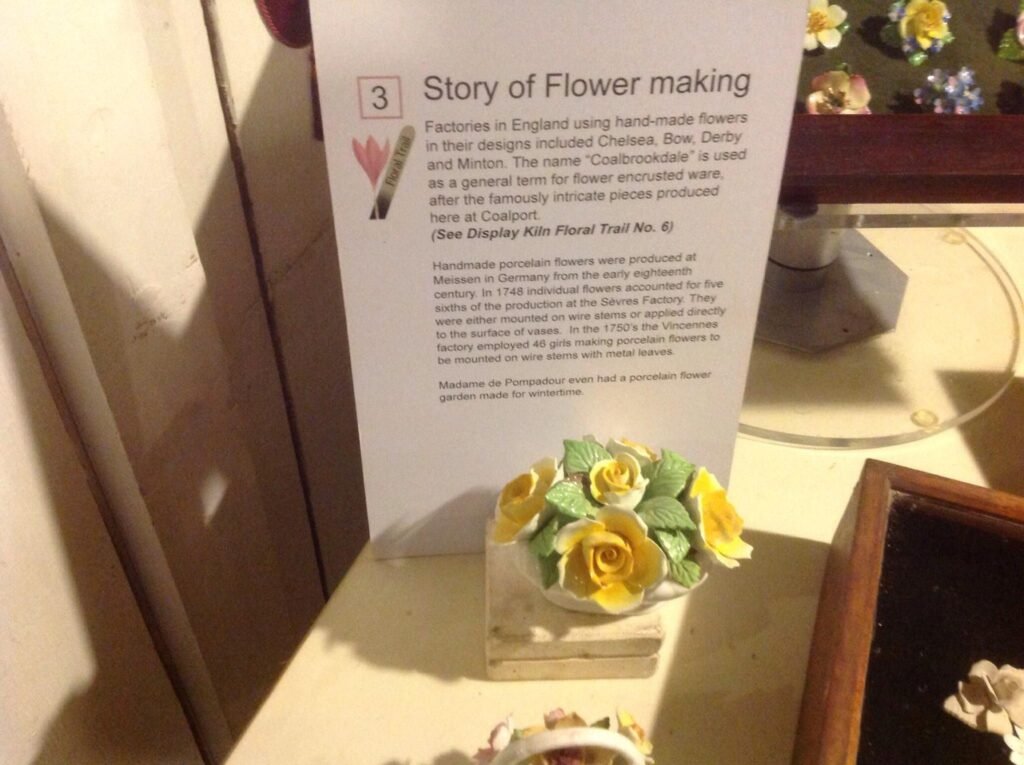Bone China Flowers
Carolyn Clayton has been making fine bone china flowers since May 2004. Starting as a voluntary role it became a paid part time job which she still does today. She finds it very therapeutic and rewarding. Her love of flower making are what led her to develop her quirky flower people.

Bone China Clay
Bone china clay is a type of porcelain that is made with 50% animal bone ash, 25% china clay (kaolin) & 25% china stone (feldspar). It has a ‘translucent body’ due to the animal bone content and it is the whitest, finest clay porcelain. The bone also gives it some strength and it was first developed by Spode in 1799 and later used by all the potteries in England. I was expensive to produce but it was finer and whiter than all the other porcelain at the time.
Bone china clay is a very specialised clay. It is great for slip ware and slip casting, but in terms of sculpting it is only really good for making small items such as flowers.
To make bone china flowers the clay and bone needs to has to have gum arabic added to make it more pliable. Gum arabic is a plant sap and only added for bone china flower making clay, not in slip. You couldn’t make the flowers with bone china clay without gum arabic.
Bone china clay is sticky, so oil needs to be added to the hands to make it more workable.
History of Bone China Flower Making
Bone China Flowers have been hand-made to decorate pottery since the middle of the eighteenth century. They were popular in Victorian times where tiny hand made flowers were made into broaches and flowers were added to bowls and vases.
In the 1800’s Coalport China had a range of flower encrusted pottery which they called Coalbrookdale. Coalbrookdale ware was a very desirable line of hand-painted and sculpted china at its time, famous for the sculpted ornamentation and inspired use of colour.
Bone china flowers were only ever made by girls after an apprenticeship period. Those who showed potential were chosen to stay and would learn to make bone china roses, daffodils, daisies, pansies and many other flowers. All the flowers were handmade using their hands and simple tools such as a comb.
A comb was used to create spiky effects and the center of a daisy, over the years a tea sieve or metal mesh has been used.
The girls would be on piece work so the more they made the more they got paid. 500 a day was what they aimed for as this would give them a decent pay packet.
Decoration on Coalport Bone China
This is the part that has always impressed me. When Coalport and other potteries created these elaborate wares there was a lot that could go wrong. So many processes and stages where things could go wrong.
Once a piece was made, it would get a biscuit firing which took days, then if it survived it would be dipped in glazed and fired a second time. Then each colour had to go on and be fired separately as each colour had a different firing temperature. So if an object had say 6 colours on it, it would have been in the kiln 8 times. That’s a lot of firings just to get a few colours on a plate!
Now a firing back in the day when they used bottle kilns was a major job. The firings took days. The man in charge of firing the kiln was a fireman and he was the highest paid. All he had was a shovel and tons of coal (apparently 15 tons per firing) and that was it. He had the skill of getting the kiln to the correct firing temperature and not a bit above. Had he over fired, every other person involved in the pottery making of the pieces would have not be paid. The success of the potteries back in the day were down to the brilliant team work.
Firings are easier today. I have a nice electric kiln with a simple controllable panel where I tell it what temperature to fire too, then leave it and go out shopping. Simple.
The decoration of pottery has seriously evolved. You can fire all colours together at the same temperature, and add colour to wet or leather hard clay and bisc ware. You can even print a photograph from a laser printer and make your own ceramic transfers.
The Story of China Flower Making – Coalport China Museum

Factories in England using hand-made flowers in their designs included Chelsea, Bow Derby and Minton. ‘Coalbrookdale’ is used as a general term for intricate flower encrusted pottery pieces produced at Coalport.
Handmade porcelain flowers were produced at Meissen in Germany from the early eighteenth century. in 1748 individual flowers accounted for five sixes of the production at the Serves Factory. They were either mounted on wire stems or applied directly to the surface of vases. In the 1750’s the Vincennes factory employed 46 girls making porcelain flowers to be mounted on wire stems with metal leaves.
Madame de Pompadour even had a porcelain flower garden made for wintertime.
Bone china flowers are a well known form of decoration on Coalport China. They were used to decorate a range of Coalport china called Coalbrookdale Ware.
The flowers were made completely by hand from bone china clay.
At the Coalport China Works, this skilled task was usually performed by women. They could each make a china rose in about thirty seconds.
The flower makers required only simple tools.
They would use a comb made from leather, wood or bone to make indentations in the clay and a scalpel for cutting.
The most skilled flower makers had a comb made of bone as a sign of their higher status.
Flower makers today use every day objects such as tea strainers as tools. They rub cooking oil into their hands to prevent the clay sticking.
Bone china clay used to ‘go off’ very quickly and was extremely smelly.
Modern bone china clay contains special chemicals to prevent it ‘going off’ so quickly.
Coalport was founded in 1795 by John Rose. The firm later moved to Stoke-on-Trent, Staffordshire, eventually, in the modern day becoming part of the Wedgwood Group.
